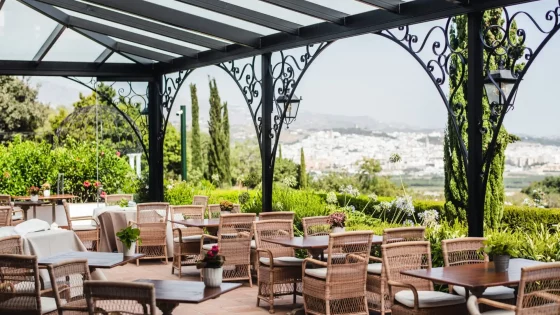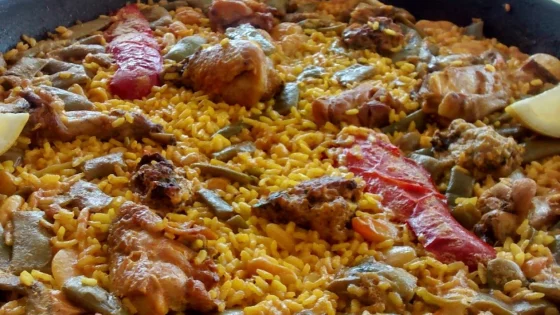
When you arrive in Córdoba and the heat starts to kick in, there’s nothing like sitting on a terrace and ordering a good salmorejo cordobés. Creamy, intense, with that hint of garlic and topped with serrano ham and hard-boiled egg.
Is your mouth watering? Then get ready, because in this article we’re going to dive into its history, the authentic recipe… even the best places to try this Andalusian delicacy.
And if you’re coming from outside, we recommend a great option to discover Cordoban cuisine at your own pace: you can hire a car without excess at Málaga Airport. This way, you’ll be able to move comfortably between taverns, monuments, and historic neighborhoods with total freedom.
Table of Contents
History of Salmorejo Cordobés
Did you know that salmorejo has more history than it seems? Behind that bowl of bread and tomato lies a recipe with centuries of tradition, passed down through generations, adapting, reinventing, and conquering palates far beyond Andalusia.

Next, you’ll discover how this dish was born, why it’s so special in Córdoba, and what curiosities you should know to enjoy it even more. From its humble origin to its recognition as a national gastronomic icon, salmorejo is much more than a cold soup.
Origin of Salmorejo Cordobés
Although it may look like a modern cold soup, the truth is that salmorejo cordobés has very ancient roots and a much humbler past than it might seem.
This dish emerged as a smart way to use up stale bread left over at home, mixing it with basic pantry staples from Andalusia: garlic, vinegar, olive oil, and salt.

In its primitive form, it was a kind of thick mash, similar to ajo blanco or gazpacho without tomato. In fact, tomato (the key ingredient in modern salmorejo) wasn’t incorporated until well into the 18th century, when its use began to spread in popular cuisine after arriving from the Americas.
That’s when salmorejo acquired its distinctive reddish color and became what we now recognize as one of the great classics of Cordoban gastronomy.

There are writings from 19th-century travelers already mentioning this dish as common in Cordoban households, especially during the hottest times of the year, due to its freshness, simplicity, and ability to satisfy hunger.
One etymological theory suggests that the word “salmorejo” may derive from “salmuera” (brine), referring to those traditional garlic and vinegar mixtures used since the Middle Ages to preserve food and season cold dishes.

Today, salmorejo has crossed borders and made it onto restaurant menus across Spain and even abroad.
But only in Córdoba can you try it with the authentic texture and flavor, made with pan de telera, Montalbán garlic, and virgin olive oil from the countryside. A simple recipe, yes, but one that holds centuries of history in every spoonful.
Calleja del Salmorejo Cordobés
Yes, you read that right. Córdoba has dedicated a street to salmorejo. It’s called Calleja del Salmorejo Cordobés, a small pedestrian lane located in the Jewish Quarter, near the Puerta de Almodóvar.

The most special thing about this street is that on its walls you can find a tile with the original recipe for salmorejo. A tribute that blends art, gastronomy, and popular culture. It’s a perfect place for a stop, to snap a photo, and share that foodie moment on social media.
Also, it’s very close to the Alcázar de los Reyes Cristianos, so you can easily include it in your sightseeing route through the historic center.
Cofradía del Salmorejo Cordobés
In Córdoba, they don’t take salmorejo lightly. So much so that there is a gastronomic brotherhood dedicated exclusively to this recipe: the Cofradía del Salmorejo Cordobés.
This organization works to protect the traditional recipe, spread its history, and ensure the quality of what’s served as “authentic salmorejo cordobés” both inside and outside the city.

They organize contests, tasting events, collaborations with culinary schools, and even celebrate a Salmorejo Day every year. An event where locals and visitors can enjoy this delight for free in iconic squares and streets.
If your visit coincides with one of their events, don’t miss it. There are usually free tastings!
How is Salmorejo different from Gazpacho?
Although at first glance they may look like close relatives (both are cold, reddish, and tomato-based), salmorejo and gazpacho are two very different recipes—in texture, ingredients, and how they’re served.
1. Texture and consistency
- Salmorejo cordobés is a thick and creamy purée that’s eaten with a spoon and can even be used as a side for other dishes (for example, with fried eggplant or Spanish omelette).
- Gazpacho andaluz, on the other hand, has a much more liquid texture, similar to a cold soup. It’s drunk directly from a glass or eaten with a spoon, depending on the occasion.
2. Ingredients
- Salmorejo uses only: tomato, bread, garlic, olive oil, and salt. Nothing else. And it’s emulsified with bread (sometimes up to 20–30% of the total volume), which gives it its dense body.
- Gazpacho is lighter and includes a wider variety of vegetables: tomato, cucumber, green pepper, garlic, bread (very little or none), water, vinegar, salt, and oil. It’s a much more vegetable-based and refreshing mix.
3. Use at the table
- Salmorejo is served as a hearty starter or main appetizer, topped with hard-boiled egg and serrano ham.
- Gazpacho is enjoyed as a refreshing drink, appetizer, or very light starter, especially on extremely hot days.
4. Flavor
- Salmorejo has a smoother, creamier flavor thanks to the emulsion with oil and bread.
- Gazpacho is more acidic and refreshing, due to the vinegar and raw vegetables.
Original Salmorejo Cordobés Recipe
But do you know what’s the best part about salmorejo cordobés?
It’s an incredibly easy recipe to make at home. You just need some good ingredients.

So, if you’re one of those who prefer a good homemade dish, here’s the authentic salmorejo cordobés recipe. Simple, quick, and with ingredients you surely already have at home.
Ingredients
- 1 kg of ripe tomatoes
- 200 g of day-old bread (preferably telera bread from Córdoba)
- 1 garlic clove
- 100 ml of extra virgin olive oil
- Salt to taste
- Hard-boiled egg and serrano ham (for garnish)
How to make it
- Wash the tomatoes well and blend them into a purée.
- Strain to remove skins and seeds.
- Add the chopped bread and let it soak for a few minutes.
- Add the garlic clove and salt.
- Blend everything together until you get a smooth and dense cream.
- While blending, slowly add the olive oil to emulsify.
- Serve very cold and garnish with chopped hard-boiled egg and diced serrano ham.
The secret lies in the quality of the bread and oil. Use high-quality ingredients and you’ll taste the difference!
White Salmorejo Recipe in Córdoba
As with any popular recipe, there are many variations of salmorejo cordobés. One of them is white salmorejo.

Unlike the classic version, this dish contains no tomato and has a slightly different texture.
Ingredients
- 250 g of peeled raw almonds
- 150 g of bread crumbs
- 1 garlic clove
- 100 ml of extra virgin olive oil
- A splash of vinegar
- Cold water and salt
How to make it
- Blend the almonds with the garlic and a little water.
- Add the bread crumbs and let them soak.
- Add the vinegar and salt.
- Blend everything while slowly adding the oil.
- Serve very cold, garnished with peeled grapes or small pieces of melon.
This dish is reminiscent of ajoblanco, also very popular in other parts of Andalusia, but with its own Cordoban twist.
Where to eat the best salmorejo cordobés
Let’s get to the point: where can you eat the best salmorejo cordobés? As with any traditional dish, every family and every tavern has its own version. But some places have earned their fame on merit.
Here are some must-visit stops for any food lover.
Taberna el Salmorejo
Located in the heart of Córdoba, Taberna El Salmorejo lives up to its name with one of the most faithful versions of the original recipe.

The texture is perfect, the garlic is well balanced, and the oil is always extra virgin.
- Opening hours: Tuesday to Sunday from 9:00 to 16:00.
- Price: between €10–20 per person.
- Location: Calle Mayor de Sta. Marina, Centro, 14001 Córdoba.
Restaurante Sociedad de Plateros María Auxiliadora
Another iconic spot to try authentic salmorejo and other Cordoban delights. Founded over 70 years ago, this tavern blends tradition with quality.

- Opening hours: Monday to Saturday from 11:00 to 16:00 and from 20:30 to 00:00. Sundays from 11:00 to 16:00.
- Price: between €10–20 per person.
- Location: Calle María Auxiliadora, 25, Centro, 14002 Córdoba.
It’s just a few minutes’ walk from Calleja del Salmorejo, so you can enjoy both culture and gastronomy in one go.
Taberna la Montillana
Another gem in the city center. Here you’ll find a traditional salmorejo with perfectly balanced flavors. Plus, the menu includes modern takes on Cordoban dishes.

- Opening hours: every day from 13:00 to 16:00 and from 19:30 to 23:30.
- Price: between €20–30 per person.
- Location: Calle San Álvaro, 5, Centro, 14003 Córdoba.
Bodegas Campos
If you’re looking for an elegant setting without sacrificing authentic flavor, this restaurant combines Cordoban tradition with fine dining. Its salmorejo is award-worthy.
- Opening hours: every day from 13:00 to 16:00 and from 19:00 to 23:00.
- Price: between €20–30 per person.
- Location: Calle Lineros, 32, Centro, 14002 Córdoba.
Restaurante Casa Pepe de la Judería
A classic in the historic center, perfect for a meal after visiting the Mezquita-Catedral. The salmorejo is served with Iberian acorn-fed ham and grated hard-boiled egg, with a smooth texture and great flavor.
- Opening hours: every day from 13:00 to 16:00 and from 20:00 to 23:30.
- Price: between €20–30 per person.
- Location: Calle Romero, 1, Centro, 14003 Córdoba.
Bar Santos
Although this small bar is famous for its giant Spanish omelette, its salmorejo also deserves a spot in this post. It’s a quick, tasty, and affordable option right in front of the Mezquita.

- Opening hours: every day from 10:00 to 00:00.
- Price: between €10–20 per person.
- Location: Calle Magistral González Francés, 3, Centro, 14003 Córdoba.
Taberna Salinas
Another historic spot that has been serving Cordoban food since the 19th century. Their salmorejo is 100% homemade, with telera bread and local virgin olive oil.
- Opening hours: Monday to Friday from 12:30 to 16:00 and from 20:00 to 23:30. Saturdays from 12:30 to 16:00. Closed on Sundays.
- Price: between €20–30 per person.
- Location: Calle Tundidores, 3, Centro, 14002 Córdoba.
Map of where to eat salmorejo in Córdoba
To help you better plan your culinary route through the city, we’ve prepared a map with all the recommended restaurants and taverns mentioned in this post.
That way, you’ll know exactly where to eat the best salmorejo cordobés. If you look at the map, you’ll notice that some of the marked spots are close to major landmarks.
If you choose to eat at Casa Pepe de la Judería or Bar Santos, take the opportunity to visit the Mezquita-Catedral, the Roman Bridge or the Triumphal Arch, which are right next door.



